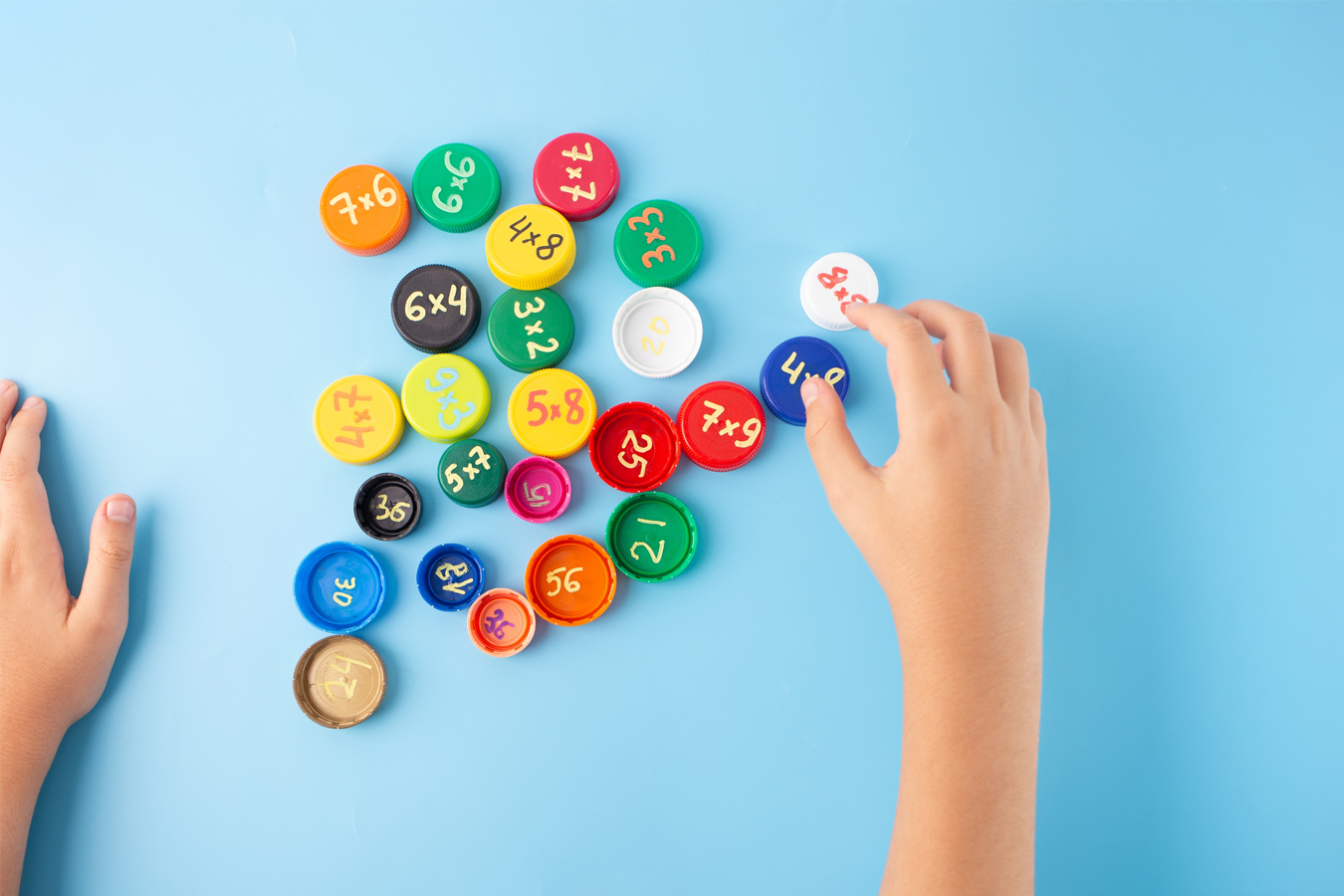When your child declares war on fractions, these simple shifts can transform homework battles into breakthrough moments.
“I’m not a math person. I hate math.”
If you’ve heard these words from your child, you’re not alone. I hear this constantly, and honestly? It breaks my heart every time.
Because here’s what I’ve discovered after working with hundreds of teachers and thousands of students: every single person can navigate numbers.
Every. Single. One.
The problem isn’t your kid. It’s how we’ve been approaching math.
With a few simple shifts, you can help your child go from “I hate math” to “Wait, that’s actually kind of cool!”
1. Stop saying “we’re not math people” in your house.
The other day, I heard a sophisticated, successful woman literally shrink when someone mentioned I teach math. “Oh, we’re not math people in our family,” she said.
This is so hard to hear because it’s like saying, “We’re illiterate in our family.” Math is that foundational. And this isn’t just 5% of families, I’m talking about many, many, many families who’ve adopted this limiting belief and are (unknowingly) passing it down to their children.
The surprising truth?
Math is actually a creative subject.
It’s not black and white – it’s about exploring different options and finding different ways to get to the right solution.
Yes, there are right and wrong answers, but there are so many ways to play with the concepts. And they can actually be fun.
The fix: Banish “math people” language from your vocabulary. Your child is listening.
2. Get curious about their thinking (instead of focusing on the right answer)
When your child solves a problem, try this magic question: “I’m curious how you figured that out. What were you thinking?”
This simple shift reveals whether they actually understand the math or are just following steps blindly.
True story from one of my tutoring sessions: Aliza* was convinced she couldn’t do math. I put a simple problem in front of her: 7 + 8. She solved it and got 15. When I asked how she figured it out, she said, “Well, I decided to add 10 and then just took two away instead of adding eight.”
I said, “That’s crazy! You know, it’s called COMPENSATION, the name in the math book for when you do a little extra to make it easier for yourself!”
Her whole face lit up. She was able to learn so much more because of that. Suddenly, what she thought was just random thinking had a name and was actually sophisticated mathematical reasoning.
3. Don’t teach them “your way” if they learned something different at school.
This is huge. If your child comes home with a method you don’t recognize and can’t show you how it works, please resist saying, “You know, when I was a kid, we did long division differently. Let me show you how it’s really done.”
You will likely confuse them. Just send the teacher a note saying, “My child did not understand how to do this. Could you go over it?”
There’s likely a specific strategy happening at school, and when you introduce a different method, your child ends up knowing two confusing ways instead of one clear way.
And then follow up with, “After you understand how your teacher taught it, can you come to me and show me how?”
This invites your child to teach YOU, building their self-esteem further. They’ll listen carefully as their teacher explains, so they can enlighten you when they get home!
4. Make math relevant to their world
Kids engage when they see the point. The good news? Math opportunities are everywhere in your daily routine.
Quick wins:
- Pizza for supper = fractions in action
- Planning allowance spending (and maaser) = percentages and budgeting
- Measuring for room decorating = geometry and measurement
- Figuring out party favors or setting the Shabbos table = multiplication and division
When math connects to their real life and feels relevant, the underlying understanding is reinforced in a whole new way.
5. Don’t help right away
When you put a problem in front of your child, resist the urge to jump in immediately. Give them a moment to think. You might be surprised by the solutions they come up with when given the space.
I know it’s hard to watch them struggle, but that thinking time is where the real learning happens.
For teachers: 4 simple classroom shifts
If you’re an educator reading this, here are 4 powerful moves that could transform math learning:
- Understand what’s really behind math anxiety. Math anxiety typically sets in around third grade, when we begin memorizing our times tables. Not because we shouldn’t memorize them – I’m a big believer in fluency! But because of the way we’ve been pressured to memorize them.
We can’t just give them an 8 x 6 = ? flashcard and think they’re going to remember it, never mind apply it to real life. Here’s what should happen first: Deep conceptual understanding.
When you build memorization on understanding, it becomes part of them. They get it. If they understand how multiplication works, they’re not memorizing random facts; they’re strengthening connections they already have. Kids need a relationship with those numbers before they ever see flashcards.
When memorization is built on a bed of understanding, it sticks. When it’s not, it creates anxiety.
- Let them talk to each other about math. Sometimes kids explain concepts to their peers more brilliantly than we ever could. They use language that resonates in ways we adults never think of.
- When a student gets a wrong answer, don’t just say “no.” Instead, ask, “Tell me how you solved that. Tell me more.” Very often, students will self-correct once they walk through their thinking out loud. This turns a potentially discouraging experience into an empowering moment.
- Give kids quiet thinking time. I know it feels unsettling when you’re used to being “on” for 45 minutes straight, but there’s something incredibly powerful about letting kids sit with math problems in silence. They need space to process and let their mathematical creativity emerge. A simple way to do this? After you ask a question, just pause and wait a little longer than you’re comfortable with. Quietly. You might just be rewarded with way more hands up in the air than you’re used to.
Less Stress, More Success (and that doesn’t mean we’re lowering the bar!)
When we change how we approach math – with curiosity instead of pressure, understanding before memorization, and connection instead of isolation – we don’t just improve grades. We change how children see themselves.
Your child is more mathematically capable than they (or you) realize! Sometimes they just need someone to notice and celebrate their thinking.
You’ve got this. Here’s to fewer homework battles and more “aha!” moments around your kitchen table!




Such practical ideas! Thanks for giving us this shift in thinking and empowering us to deal with math drama.
This post came at a great time for me
My daughter came home confused
And I was feeling inspired
So I composed a “friends of 10” song for her
She made the motions and we keep practicing
Some additional tips:
1 – If your child is already behind the rest of his/her class, teach the fact families in the order that is easiest for him or her. [This usually includes 0, 1, 2, 5, (9 if you’re doing the finger trick) and 10.]
2 – When doing the five times table, if your child knows how to tell time, have him/her think of the numbers on the clock to get the correct answer. If s/he doesn’t know how to tell time, teach the five times table and then reinforce it by teaching him/her to tell time. (Like multiplication, this is also a skill that s/he will need for life.)
Continued:
3 – As soon as you teach a set of multiples, have your child practice it both ways – 2×1 & 1×2, 2×3 & 3×2, 2×4 & 4×2, etc. [Once your child learns a fact (or a set of facts), use flashcards or a multiplication chart to show him/her how much s/he knows in comparison to how little there is left to learn. To a child who is struggling, it can really feel endless but in reality there is less and less to memorize as you go along. For example, after learning the tables listed in #1, there are only 15 facts left to memorize.]
4 – Practice to the point of automaticity before moving on. Moving on too early will cause the child to forget what he/she has already learned.
5 – Use hints!
3×3 – 3 Yiddish-speaking boys turned three on the same day. Their Rebbi asked them if they know how many years old they are altogether. They answered, “Nein”. The Rebbi was amazed, “How did you know the answer?!” (For the non-Yiddish speaking: “nein” means both “no” and “9”)
3×4 – After the three Avos and the four Imahos came the 12 shevatim.
7×7 – Sing the sefiras ha’omer song, “Seven weeks, seven weeks, forty-nine days”.
There are lots of books that you can buy that will help you and your child understand mutiplication!
Once you buy one or search for one, you can see what else is “also bought by” and figure out what works.
Also, TPT, which is Teachers Paying Teachers has tons of worksheets for a few dollars each set that are really better than the free ones.
Five times five is NOT Ten- This book has many ideas to remember the facts, and does NOT go in order of the tables
Multiplication in a Flash- This book has hints and pictures to remember the facts and does NOT go in order; also has games.
Multiplication Facts that Stick- This book goes in order, shows ten frames, and has simple games to get a lot of practice